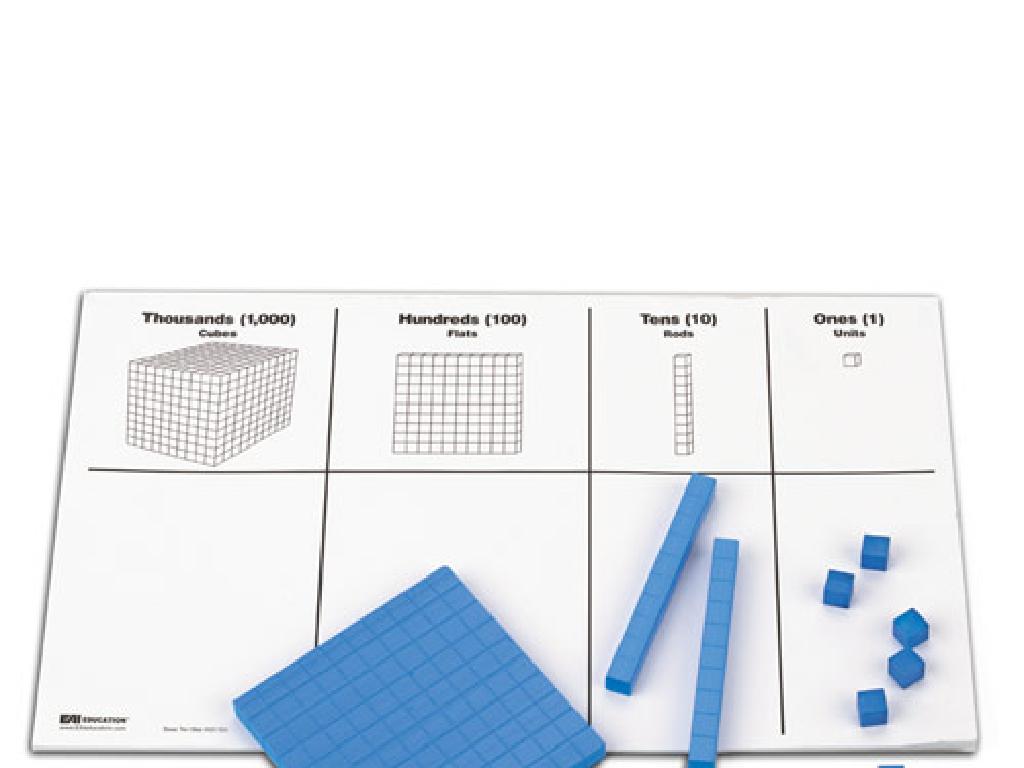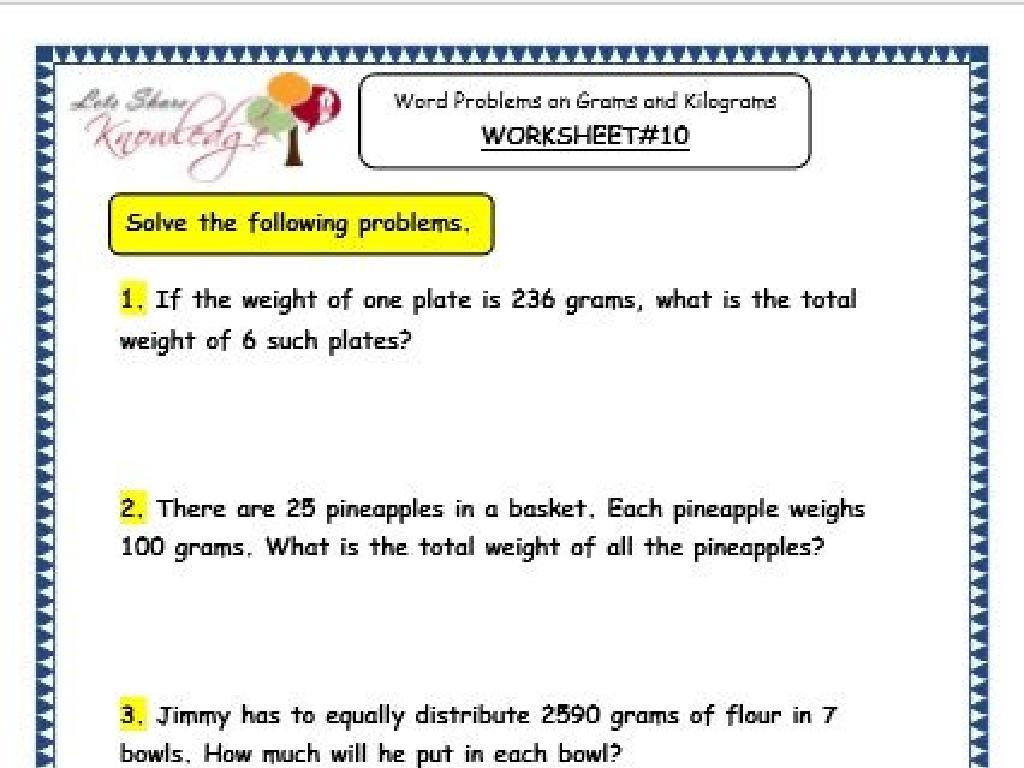How Does Mass Affect Force And Acceleration?
Subject: Science
Grade: Seventh grade
Topic: Velocity, Acceleration, And Forces
Please LOG IN to download the presentation. Access is available to registered users only.
View More Content
How Mass Affects Force and Acceleration
– Define mass, force, acceleration
– Mass: amount of matter in an object. Force: a push or pull. Acceleration: change in velocity.
– Mass’s role in force
– According to Newton’s second law, force equals mass times acceleration (F=ma).
– Mass’s influence on acceleration
– Heavier objects need more force to accelerate the same as lighter ones.
– Interrelation of mass, force, acceleration
– Understanding these concepts is crucial for solving physics problems.
|
Begin the lesson by defining the key terms: mass, force, and acceleration. Explain that mass is a measure of how much matter an object contains, force is any interaction that, when unopposed, will change the motion of an object, and acceleration is the rate at which an object changes its velocity. Discuss Newton’s second law of motion, which states that the force acting on an object is equal to the mass of that object multiplied by its acceleration (F=ma). Highlight that the greater the mass of an object, the more force it will require to change its acceleration. Encourage students to think about real-world examples, such as pushing a heavy vs. a light shopping cart, to illustrate these concepts. This foundational understanding will help students as they delve deeper into physics and explore more complex problems.
Understanding Mass in Physics
– Mass: Measure of matter
Mass is how much ‘stuff’ is in an object.
– Units: Kilograms and grams
We use kg and g to quantify mass.
– Mass versus Weight
Mass is constant; weight changes with gravity.
– Mass’s role in force and acceleration
More mass means more force needed for the same acceleration.
|
This slide introduces the concept of mass as a fundamental property of matter, which is crucial for understanding force and acceleration. Mass is measured in kilograms or grams and is different from weight, which is affected by gravity. It’s important for students to grasp that while an object’s mass stays the same regardless of its location, its weight can change if the force of gravity changes. This distinction will be vital when discussing how mass affects an object’s ability to accelerate under a given force, following Newton’s Second Law of Motion.
Understanding Force in Motion
– Force: a push or pull on an object
– Like a kick to a soccer ball or pulling a door open
– Measuring force in Newtons (N)
– One Newton is the force needed to accelerate 1 kg of mass at 1 m/s²
– Force effects: acceleration and motion
– Forces make things speed up, slow down, or change direction
– Force can also resist change
– Objects at rest stay at rest unless a force acts upon them
|
This slide introduces the concept of force to students, explaining it as a push or pull that can cause an object to move, stop, or change its motion. It’s measured in Newtons, a unit named after Sir Isaac Newton. Students should understand that force is not just about movement; it can also hold things in place or resist changes to an object’s shape or state of rest. Examples in the notes can include pushing a toy car to make it move (force causing acceleration) or a book resting on a table (force resisting motion due to gravity).
Acceleration Explained
– Acceleration: change in velocity
– It’s how quickly an object speeds up, slows down, or changes direction.
– Measured in m/s^2
– Caused by speed or direction changes
– Mass affects acceleration
– More mass means more force needed for the same acceleration.
|
Acceleration is a fundamental concept in physics that describes how quickly an object changes its velocity. It’s important for students to understand that acceleration is not just about speeding up; it can also mean slowing down or changing direction. The unit of acceleration is meters per second squared (m/s^2), which can be a bit abstract, so use real-life examples like a car accelerating or a ball being thrown. Emphasize the relationship between mass, force, and acceleration, which is described by Newton’s Second Law of Motion. For instance, if two objects have the same force applied to them, the object with less mass will accelerate more. This slide sets the stage for further discussion on how mass affects force and acceleration.
Newton’s Second Law of Motion
– Force equals mass times acceleration
– F = m x a explains how force, mass, and acceleration are related
– More mass requires more force
– A heavier object needs a stronger push for the same speed change
– Less mass requires less force
– A lighter object needs a smaller push to accelerate
– Relationship affects motion
|
This slide introduces Newton’s Second Law of Motion, which is a cornerstone in understanding the relationship between mass, force, and acceleration. The law tells us that the force needed to accelerate an object is directly proportional to the mass of the object and the acceleration required. This means that if you have two objects and you want to push both to the same acceleration, the heavier object will require more force. Conversely, a lighter object will need less force to achieve the same acceleration. This concept is fundamental in explaining why different objects move the way they do when a force is applied. Use examples like pushing a car versus pushing a bicycle to illustrate this law in a way that’s relatable to seventh graders.
How Mass Affects Force and Acceleration
– Pushing different objects
– Compare pushing a light shopping cart to a heavy car
– Throwing balls of different masses
– Contrast throwing a light tennis ball with a heavy bowling ball
– Visualizing mass effects
– These examples show mass impact on force needed and speed change
– Newton’s Second Law
|
This slide aims to help students understand the concept of mass in relation to force and acceleration through tangible examples. Discuss how pushing a shopping cart, which is relatively light, requires less force and results in greater acceleration compared to pushing a heavy car. Similarly, when throwing balls, a tennis ball (lighter mass) can be thrown farther and faster than a bowling ball (heavier mass) with the same amount of force. These real-life scenarios will help students grasp how mass directly influences the amount of force required to move an object and its subsequent acceleration, as described by Newton’s Second Law of Motion. Encourage students to think of other examples where they have experienced this relationship.
Interactive Experiment: Mass and Acceleration
– Observe acceleration with different masses
– Gather materials for the experiment
– Toy car, ramp, weights, stopwatch, tape needed
– Make predictions on mass and speed
– Will heavier or lighter masses go faster?
– Record and compare results
|
This interactive experiment is designed to help students understand the relationship between mass and acceleration. Students will use a toy car and add different weights to it, then release it down a ramp to measure how fast it goes with a stopwatch. Before conducting the experiment, ask students to predict whether a heavier or lighter car will reach the bottom of the ramp faster, discussing their reasoning. After the experiment, students should record the time it takes for each mass to reach the bottom and compare the results. The teacher should guide the discussion on how mass affects acceleration, referring to Newton’s Second Law of Motion. Possible variations of the experiment could include changing the incline of the ramp or using different surfaces to explore friction’s effects.
Experiment Time!: Mass and Acceleration
– Divide into groups for the experiment
– Record time for car with varying weights
– Use a stopwatch to measure how long the car takes to reach the bottom.
– Observe mass effect on time
– Heavier cars may take longer; why could that be?
– Discuss findings on mass and acceleration
|
This class activity is designed to help students understand the relationship between mass and acceleration through a hands-on experiment. Divide the class into small groups and provide each group with a toy car, a ramp, and a variety of weights. Have students record the time it takes for the car to travel down the ramp with different weights attached. After the experiment, lead a discussion on their observations, focusing on how the mass of the car affected the time it took to reach the bottom of the ramp, and what this indicates about acceleration. Possible activities: 1) Using different ramp inclines, 2) Timing with different surface materials, 3) Adding wind resistance, 4) Using different car models.
Conclusion: Mass, Force, and Acceleration
– Recap: Mass and force relationship
– More mass means more force needed for the same acceleration
– Experiment results discussion
– How did the different masses affect the acceleration in our experiment?
– Q&A session for doubts
– Key takeaways
– Understand that force is directly proportional to mass and acceleration
|
As we conclude, revisit the fundamental concept that force is needed to change the velocity of an object, and this force depends on the mass of the object and the acceleration. Reflect on the experiment conducted, discussing how varying masses influenced the acceleration observed. Encourage students to ask questions to clear up any confusion they may have. This is crucial for solidifying their understanding of the relationship between mass, force, and acceleration. Summarize the key points to ensure that students grasp the importance of these concepts in physics and how they apply to real-world scenarios.
Homework: Mass, Force, and Acceleration Essay
– Write an essay on the experiment
– Include Hypothesis and Method
State your initial prediction and the steps you took in the experiment.
– Summarize Results
Describe the outcome of the experiment.
– Conclude your findings
What did the results tell you about mass, force, and acceleration?
|
For this homework assignment, students are expected to write a comprehensive essay detailing their experiment on how mass affects force and acceleration. They should start with their hypothesis, which is what they initially believed the outcome of the experiment would be. Next, they should describe the method, outlining the steps they followed during the experiment. Students must then summarize the results they observed, providing data and observations. Finally, they should write a conclusion that discusses what the results mean in the context of the experiment and whether their hypothesis was supported. The essay is due the next class session, and students should be prepared to discuss their findings. This exercise will help them understand the scientific method and the relationship between mass, force, and acceleration.





